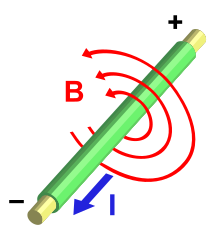Ampere's circuital law relates the integrated magnetic field around a closed loop to the electric current passing through the loop.
Using Ampere's law, one can determine the magnetic field associated with a given current or current associated with a given magnetic field, providing there is no time changing electric field present.
The magnetic field in space around an electric current is proportional to the electric current which serves as its source, just as the electric field in space is proportional to the charge which serves as its source.
Ampere's Law states that for any closed loop path, the sum of the length elements times the magnetic field in the direction of the length element is equal to the permeability times the electric current enclosed in the loop.

Using Ampere's law, one can determine the magnetic field associated with a given current or current associated with a given magnetic field, providing there is no time changing electric field present.
Ampere's Law states that for any closed loop path, the sum of the length elements times the magnetic field in the direction of the length element is equal to the permeability times the electric current enclosed in the loop.

(An electric current produces a magnetic field.)
In terms of total current, which includes both free and bound current, the line integral of the magnetic B-field (in tesla, T) around closed curve C is proportional to the total current Ienc passing through a surface S(enclosed by C):
where J is the total current density (in ampere per square metre, Am−2)
Alternatively in terms of free current, the line integral of the magnetic H-field (in ampere per metre, Am−1) around closed curve C equals the free current If, enc through a surface S:
where Jf is the free current density only.
 is the closed line integral around the closed curve C,
is the closed line integral around the closed curve C, denotes a 2d surface integral over S enclosed by C
denotes a 2d surface integral over S enclosed by C- • is the vector dot product,
- dℓ is an infinitesimal element (a differential) of the curve C (i.e. a vector with magnitude equal to the length of the infinitesimal line element, and direction given by the tangent to the curve C)
- dS is the vector area of an infinitesimal element of surface S (that is, a vector with magnitude equal to the area of the infinitesimal surface element, and direction normal to surface S. The direction of the normal must correspond with the orientation of C by the right hand rule),
The B and H fields are related by the constitutive equation
where μ0 is the magnetic constant.
The Ampere unit:
The Ampere unit:
Ampere is a unit of current.
A current of one ampere is one coulomb of charge going past a given point per second:
In general, charge Q is determined by steady current I flowing for a time t as Q = It.
------------------------
Ref: Wikipedia




No comments:
Post a Comment